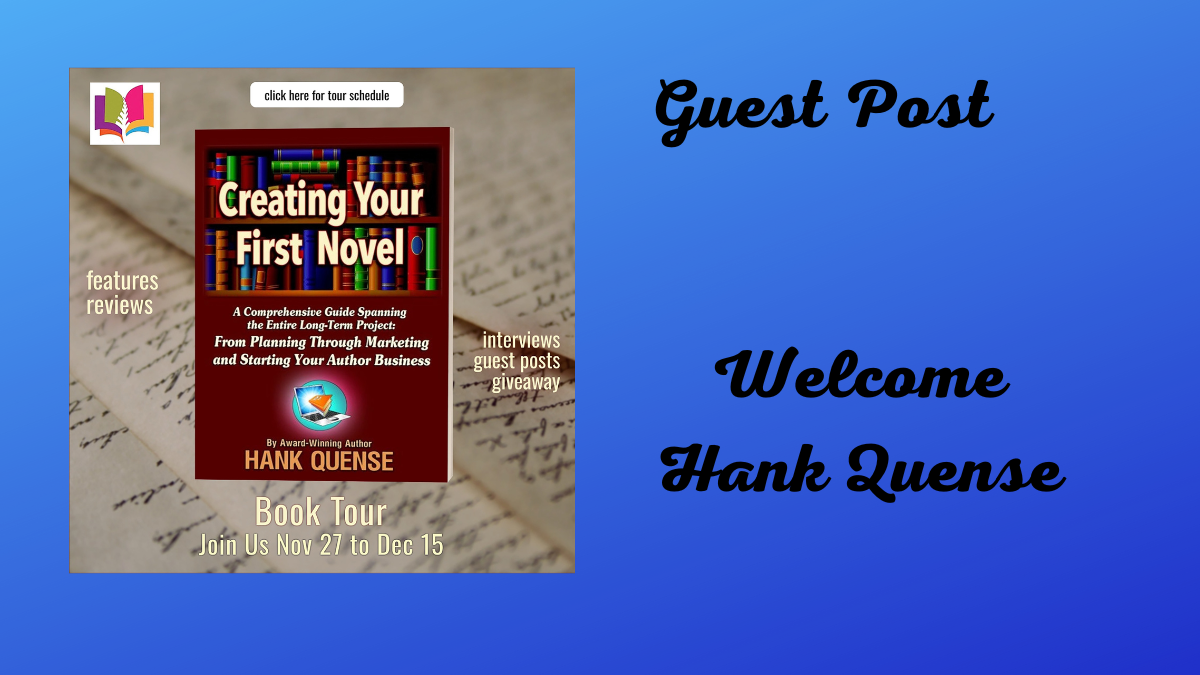Guest Post – Hank Quense – Getting started with a Story
Links in this post may be affiliate links. Purchases made using these links will not cost you more but may pay me an affiliate fee. We are a participant in the Amazon Services LLC Associates Program, an affiliate advertising program designed to provide a means for us to earn fees by linking to Amazon.com and related sites. Thank you for using my links.
Category: Adult Non-Fiction, 120 pages
Genre: Non-Fiction, Self Help,
Publisher: Strange Worlds Publishing
Release date: Oct 15, 2023
Content Rating: G
Are you writing your first book? Or are you thinking about writing it?
Do you have any idea what you’re getting into?
No? Let’s talk about it.
Most aspiring authors concentrate on writing the book to the exclusion of all else. However, the reality is that creating a book is a long-term, multi-phase project and writing it is only one facet of the project.
The complete project involves five separate phases:
- Planning the book
- Writing the book
- Publishing the book
- Marketing the book
- Author business issues
Unfortunately, planning and writing a book does nothing to prepare the author for the other phases of the project. The only commonality between the phases is that they are about a single book.
Another difficulty with the creative project is that almost all information on the process only discusses one phase of it.
Until now.
Creating Your First Novel covers all five phases.
It is written by an author who has gone through the project over two dozen times. Creating Your First Novel provides a road map to get you through the process without losing your sanity.
Guest Post – Hank Quense – Getting started with a story
Let’s assume you are a teenager who wants to write stories but are more than a bit mushy about details. You probably know that creating a story requires a great deal of work and thinking. You may not know that the work involved is the same whether you are creating a short story, a novel, a play, a script or even a memoir.
“How can that be?” you ask. Simply because a novel, a script, a memoir, a play, a short story are all stories. And no matter what type of story you have in mind, each requires a number of common elements such as characters, plots, scenes, settings, character arcs and more.
The only difference between these types of stories is the output. What the manuscript looks like, in other words. The manuscripts for a novel and for a play will look very different, but the process of creating those manuscripts is exactly the same.
Let’s put that issue aside and discuss a different topic. Stories are the result of three separate creative processes:
Ideas
Story design
Storytelling techniques
Let’s discuss each one of these processes.
Ideas
A mistake many teenage writers make is to start writing a story when they have only a single idea. While a single idea can be the genesis of a story, no story can be written from a single idea. A short story needs perhaps dozens of ideas while a novel requires hundreds of ideas. The writer needs ideas about the character development, plot events, the setting, the character arc and the scene designs. To gather all these ideas requires time and a great deal of thinking. This is where a notebook (a real one or a digital one) comes in handy. You never know when a great idea when pop into your head.
- Story Design
What is story design? It’s the process of developing all the story elements such as characters, plot events and so forth. To put it another way, story design is the where the writer incorporates all those ideas into the story. elements
I’m a planner (as opposed to a panster) so I spend a lot of time on story design before I attempt to write the first draft. In most cases the story design process for a novel consumes three months or more. A major portion of this time is spent on determining the scenes I need to get the characters from the start of the story to the climactic scenes at the end.
- Storytelling
No matter how great your ideas are and no matter wonderful your story design is, if you don’t have the storytelling skills to hold the reader’s attention, your story is doomed. Storytelling involves the use of a number of techniques that include point-of-view, foreshadowing, show-don’t-tell, stimulus & reaction, dialog vs exposition among other topics.
I believe that once a writer understands the creative processes required to produce a story, the work can go forward more easily and more smoothly.
This article is based on material in my book Creating Stories.
Thank you so much for sharing your insight, Hank. I appreciate your words and think my audience will as well.
Views expressed in this interview/guest post do not necessarily reflect the views of this blog host.
Meet the Author – Hank Quense:
Hank Quense has self-published his books for over 12 years. His non-fiction books cover fiction writing (Creating Stories), self-publishing (How to Self-publish and Market a Book, Self-publish a Book in 10 Steps), marketing (Book Marketing Fundamentals) and author business (Business Basics for Authors).
He also lectures on these subjects in schools, libraries and on webinars.
Hank recently started https://hankquense.podia.com/ The site provides solutions to pain points (problems) for fiction writers, self-publishing authors and authors who are trying to market their books.
Connect with the Author: Website ~ X ~ Facebook ~ Pinterest ~ YouTube ~ BookBub ~ Goodreads
CREATING YOUR FIRST BOOK by Hank Quense Book Tour Giveaway
Read my review of Creating Your First Novel




